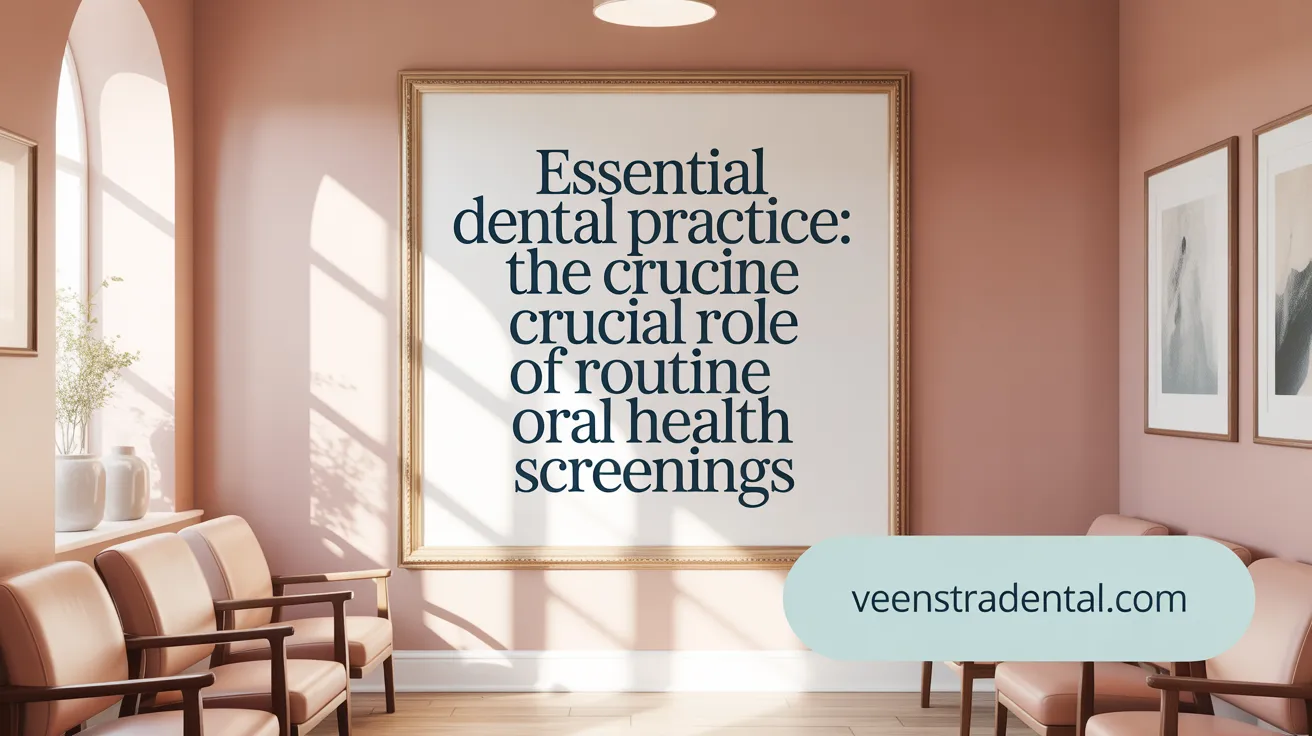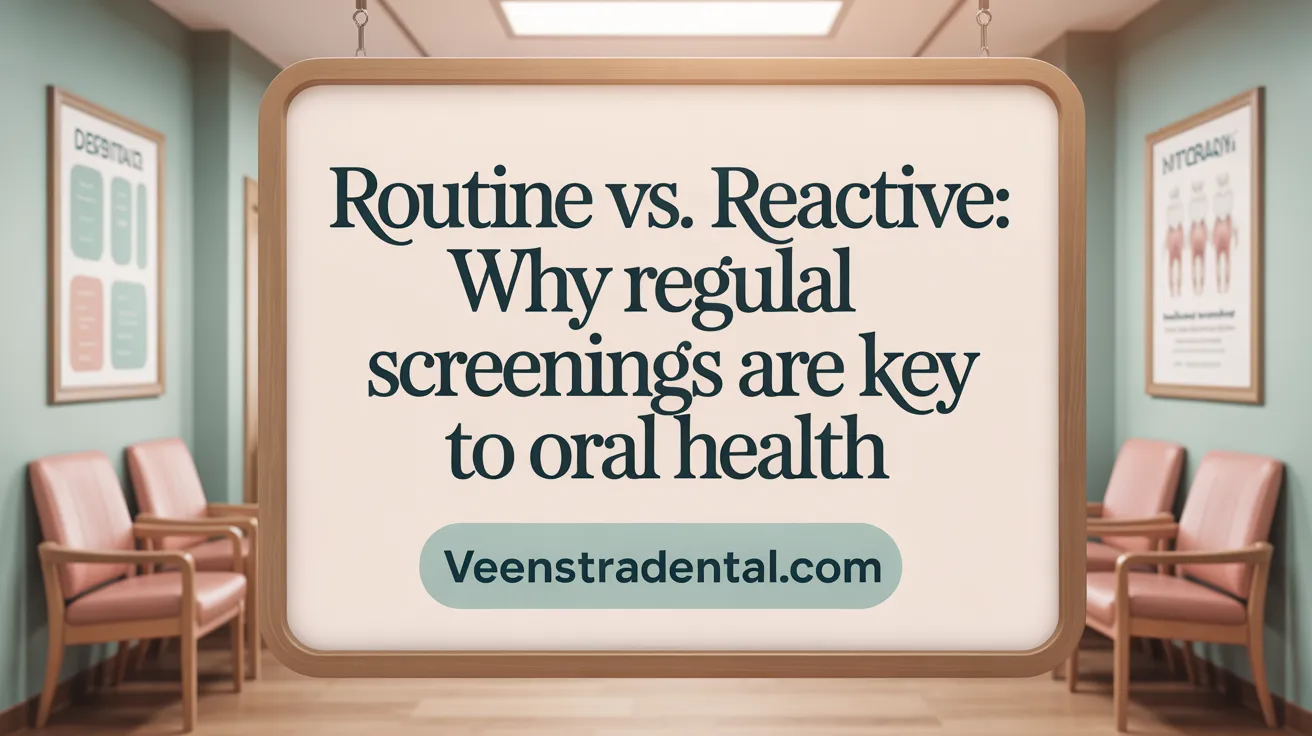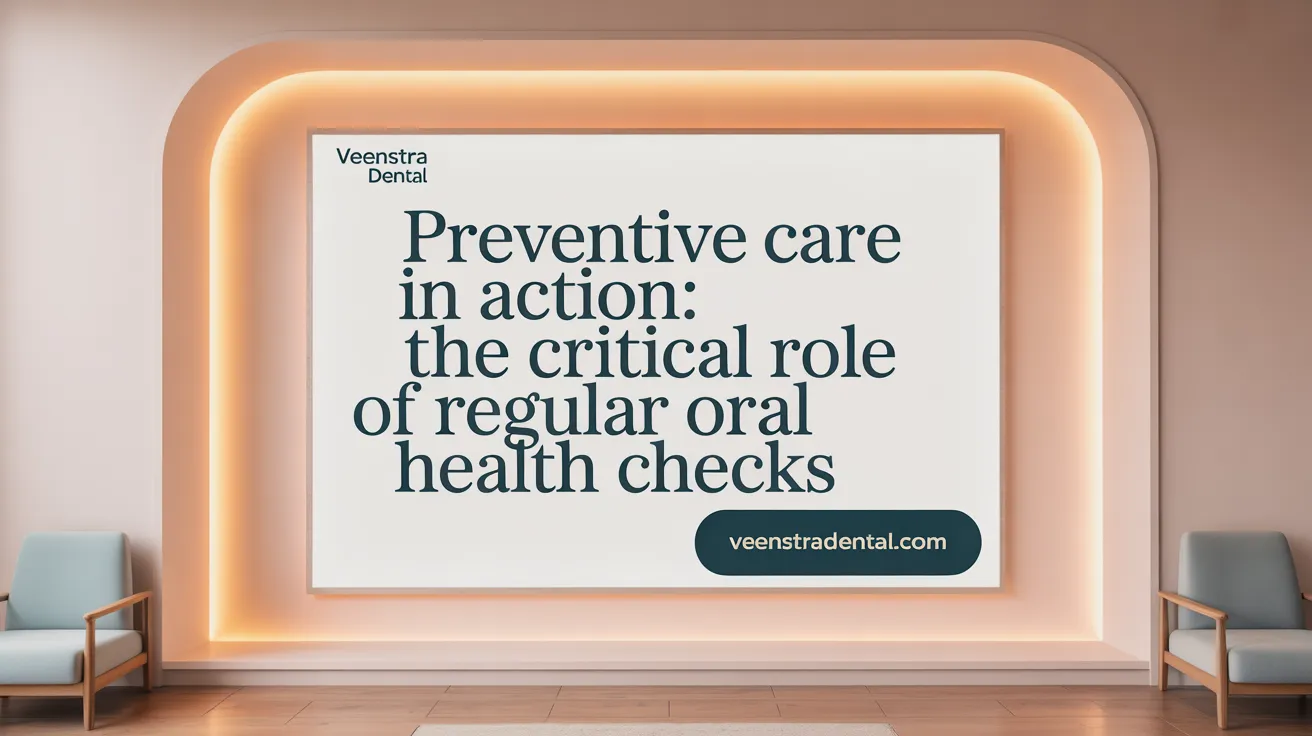Setting the Stage for Routine Screening
Oral cancer remains a significant health concern, with thousands diagnosed annually and survival rates greatly dependent on the stage at diagnosis. This places routine oral cancer screenings at the forefront of preventive dental care. Rather than waiting for symptoms to arise, proactive screenings during regular dental checkups offer the best chance to detect abnormalities early, enabling timely intervention and better outcomes. This article explores the rationale, methodology, and benefits of routine oral cancer screenings, emphasizing why they are a standard, preventive practice rather than reactive measures reserved for symptomatic detection.
The Importance of Routine Oral Cancer Screenings in Dental Care

What is the importance of routine oral cancer screenings in dental care?
Routine oral cancer screenings are an essential component of preventive dental health. They allow healthcare professionals to detect abnormal or potentially malignant lesions early, often before symptoms are noticeable.
These quick and painless checks typically involve visual and tactile examinations of the mouth, throat, and neck during regular dental visits. This routine process enhances early detection, which is crucial since oral cancers can develop silently and progress rapidly.
Identifying signs such as persistent mouth sores, lumps, or unusual patches at an early stage significantly increases the likelihood of successful treatment and survival. Studies suggest that early detection can boost treatment success rates to 80-90%, saving many lives.
Screenings also serve to identify individuals at higher risk due to factors like tobacco use, heavy alcohol consumption, HPV infection, or prolonged sun exposure. Recognizing these risk factors enables targeted education, closer monitoring, and early intervention.
Including oral cancer screenings regularly in dental care promotes overall health, raises patient awareness, and fosters proactive health management. It ensures that potential issues are addressed promptly, reducing the chances of disease progression and improving patient outcomes.
Why Oral Cancer Screenings Are Conducted Regularly Rather Than Reactively

Why should oral cancer screenings be conducted regularly rather than reactively?
Regular oral cancer screenings are an essential part of proactive healthcare. Instead of waiting until symptoms become severe or painful, routine screenings aim to identify early signs of abnormal growths or pre-malignant changes in the mouth. This early detection is crucial because oral cancers are often symptomless in their initial stages, making them easy to overlook.
These screenings allow dental professionals to systematically examine all parts of the mouth, including areas that might be hard for patients to see or feel. Advanced tools such as special lights, dyes, or magnification devices aid in identifying suspicious lesions early. Detecting abnormalities before they develop into invasive cancer increases the chances of successful, less invasive treatment.
Focusing on high-risk populations—such as tobacco and alcohol users or those infected with HPV—further enhances the effectiveness of screening programs. Since the demographics of oral cancer are shifting towards younger individuals with different risk profiles, regular screenings remain vital in catching cases early, regardless of age.
The main benefit of this approach is that it can lead to better outcomes, lower treatment costs, and improved quality of life. While evidence on mortality reduction through routine screening in the general population remains limited, targeted and modern screening techniques offer promising prospects for early diagnosis.
Overall, regular oral cancer screenings serve as a preventive tool to maintain oral health, reduce the risk of advanced stage diagnosis, and ultimately save lives by enabling timely, effective treatment.
The Benefits of Early Detection and Prevention Through Routine Screening

What are the benefits of early detection and prevention through routine oral cancer screening?
Regular oral cancer screening offers crucial advantages by catching suspicious lesions early when they are more manageable and treatable. This proactive approach enables healthcare providers to identify abnormalities such as unusual sores, lumps, or tissue changes before symptoms develop, which significantly improves the chances of successful treatment.
Screenings are quick, painless, and non-invasive, making them easy to include in routine dental visits. This convenience encourages more people to undergo regular checks, helping to detect potential issues at an early stage. When oral cancer is diagnosed early, less aggressive, less invasive treatments are often needed, reducing patient discomfort and preserving oral function.
Advances in diagnostic technology further enhance detection accuracy. Tools like fluorescence imaging and emerging biomarkers support early diagnosis, leading to better outcomes and potentially reducing the need for extensive surgeries or chemoradiation.
Population health benefits are substantial. Early detection not only improves individual survival rates but also contributes to wider public health efforts to reduce the burden of oral cancer. Although research continues to assess its impact on decreasing mortality at a broad level, the importance of routine screening as a preventive tool remains clear.
Overall, consistent screening plays a vital role in reducing oral cancer morbidity, enhancing treatment success, and improving patients' quality of life—underscoring the value of integrating regular oral examinations into comprehensive health care routines.
Methodology and Purpose of Routine Oral Cancer Screenings

What is the purpose and methodology of routine oral cancer screenings?
Routine oral cancer screenings are performed to identify early signs of cancer or pre-cancerous conditions within the mouth. Detecting these abnormalities early is crucial because it significantly increases the chances of successful treatment and survival.
The typical approach involves a quick, painless process during regular dental visits. Healthcare providers, often dentists or trained medical professionals, begin with a visual inspection of the entire oral cavity. This includes examining the lips, cheeks, gums, tongue, roof and floor of the mouth, and the throat. They also palpate or gently feel the neck and jaw area to detect lumps or irregularities that could indicate underlying issues.
In addition to visual and tactile examinations, various adjunctive tools may be used to enhance detection. Special lights, such as fluorescence or VELscope, and dyes like toluidine blue can highlight suspicious tissues that might be harboring abnormal cells.
If any abnormal areas are identified, further diagnostic steps are taken. These may include a tissue biopsy, where a small sample of tissue is taken for laboratory analysis, or cytology tests to examine cells for signs of malignancy. These follow-up procedures confirm whether the lesion is cancerous or pre-cancerous.
Overall, the goal of these assessments is early detection—catching potential problems before symptoms appear or disease progresses—making the process an essential part of preventive healthcare.
| Aspect | Description | Additional Details |
|---|---|---|
| Screening techniques | Visual examination, palpation, adjunctive tools | Use of special lights, dyes |
| Areas examined | Lips, cheeks, gums, tongue, palate, throat, neck | Entire mouth and surrounding structures |
| Follow-up procedures | Biopsy, cytology, further testing | For abnormalities or suspicious findings |
| Importance | Early detection improves prognosis | Reduces late-stage diagnosis and mortality |
Regular screenings, typically conducted annually or more frequently for high-risk individuals, serve as a frontline method for early identification of oral cancer, ultimately improving patient outcomes and survival rates.
Evidence Supporting the Practice of Regular Oral Cancer Screening
Multiple studies and national programs provide evidence that supports the importance of regular oral cancer screening.
Large-scale research from countries like India and Taiwan demonstrates tangible benefits. The Kerala trial, a significant project, reported an 81% reduction in oral cancer mortality when high-risk groups were screened regularly over several years. Similarly, Taiwan's screening program showed a 26% decrease in death rates related to oral cancer, emphasizing the potential life-saving impact of systematic screening.
These findings suggest that targeted screening efforts, especially among high-risk populations such as tobacco users, betel quid chewers, and heavy alcohol consumers, can lead to earlier diagnosis and better outcomes. Studies indicate that visual oral examinations, which are simple and non-invasive, have acceptable sensitivity and high specificity—98% in trained non-expert examiners—making them practical for widespread use.
However, some organizations like the US Preventive Services Task Force highlight the limited evidence for population-wide screening, citing the need for more definitive research. Despite this, ongoing investigations continue to show promising results. Repeated, risk-based screening approaches tend to detect malignant and premalignant lesions earlier, reducing the incidence of late-stage diagnoses—and consequently, improving survival rates.
In summary, the accumulated evidence underscores the vital role of routine oral cancer screening in early detection. When integrated into regular dental care and targeted at high-risk groups, it significantly contributes to reducing mortality and enhancing patient outcomes.
Distinguishing Routine, Proactive Screenings from Reactive, Symptom-Driven Checks
What are the differences between proactive and reactive screening?
Routine oral cancer screenings are preventive measures carried out during regular dental visits regardless of whether a patient shows any symptoms. These proactive assessments involve visual inspection, palpation, and the possible use of special tools like stains or lights to detect abnormal tissues at an early, often asymptomatic stage. The aim is to identify signs of cancer or pre-cancerous changes before they cause noticeable symptoms.
Reactive screenings, on the other hand, happen after a patient notices symptoms such as persistent sores, lumps, pain, or difficulty swallowing. These examinations are typically more urgent, focusing on diagnosing the cause of specific symptoms and may involve additional tests like biopsies. While reactive checks respond to existing signs of disease, proactive screenings are designed to catch issues early when they are more treatable.
How do screening techniques and timing differ?
Proactive screenings are quick, painless, and integrated into routine dental checkups, often scheduled on a yearly basis or more frequently for high-risk individuals. They primarily involve visual and tactile examination of the mouth, throat, and neck, with optional use of adjunct technologies.
Reactive screenings are prompted by symptoms present in the patient, calling for an immediate and sometimes more comprehensive assessment. The timing depends on the appearance of symptoms, and the examinations may involve more targeted, urgent investigations.
Why is early, asymptomatic detection advantageous?
Detecting oral cancer early, before symptoms emerge, significantly improves treatment outcomes. When cancer is caught early, the five-year survival rate increases markedly—from around 40% for advanced stages to over 80-90% for localized disease.
Early identification often means less invasive treatments, better quality of life, and higher chances of complete recovery. Moreover, marking the transition from a normal cell to a malignant one can be halted or reversed if caught early, preventing progression to more severe disease.
How important is patient education about screening?
Educating patients about the importance of regular, proactive oral cancer screenings encourages participation in preventive care. Many are unaware that these assessments are simple, quick, and painless, often incorporated into standard dental visits.
Understanding that screenings are not only for symptomatic individuals but a routine health measure can motivate higher compliance, especially among high-risk groups like tobacco or alcohol users. Patient awareness reduces the stigma and fear about oral examinations, ultimately saving lives through early detection.
| Aspect | Routine Screening | Symptom-Driven Screening | Purpose | Timing | Outcome Focus |
|---|---|---|---|---|---|
| When | During regular dental visits | When symptoms appear | Early detection and prevention | Annually or more for high-risk | Better prognosis and less invasive treatment |
| Techniques | Visual exam, palpation, special lights/dyes | Diagnostic tests based on symptoms | Identify abnormalities early | Urgency depends on symptoms | Increased survival rates |
| Patient Role | Active participation in regular exams | Seek care when symptoms occur | Reduce disease progression | As scheduled; immediately if symptoms develop | Improve overall health outcomes |
In conclusion, promoting a proactive approach to oral cancer screening emphasizes prevention, early diagnosis, and improved patient outcomes, making it an essential element of comprehensive dental care.
Routine Screenings: A Lifesaving Standard in Oral Health Care
Routine oral cancer screenings stand as a cornerstone of preventive dental care, offering a proactive strategy to detect cancer at its earliest and most treatable stages. They differ fundamentally from reactive approaches by emphasizing regular, symptom-independent examinations that save lives through early intervention. Supported by research demonstrating benefits in high-risk populations and increasingly sophisticated diagnostic tools, these screenings play an essential role in improving survival rates and reducing treatment burdens. As part of standard dental checkups, they provide a painless and efficient way to monitor oral health continuously while educating patients about risk factors and symptom awareness. Embracing routine oral cancer screenings empowers both patients and providers to take control of oral health, prevent advanced disease, and improve overall outcomes. This proactive approach reaffirms the commitment to comprehensive care where early detection is not an option but a routine practice.
References
- The Importance of Oral Cancer Screenings - Why Choose Us ...
- Screening and Early Diagnosis of Oral Cancer
- Why Oral Cancer Screenings Should Be a Routine Part of ...
- Why Screening Works
- Oral cancer screening
- The Importance of Routine Oral Cancer Screenings for ...
- Oral Cancer Screening: Past, Present, and Future - PMC
